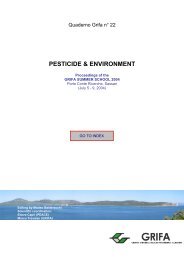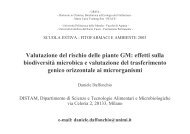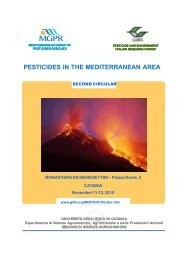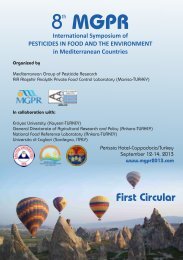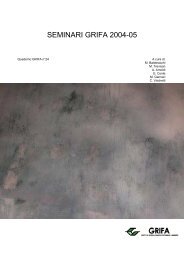International Congress BIOLOGICAL PRODUCTS - Gruppo di ...
International Congress BIOLOGICAL PRODUCTS - Gruppo di ...
International Congress BIOLOGICAL PRODUCTS - Gruppo di ...
You also want an ePaper? Increase the reach of your titles
YUMPU automatically turns print PDFs into web optimized ePapers that Google loves.
7<br />
NATURAL COMPOUNDS IN THE CONTROL OF POWDERY MILDEW ON CUCURBITS IN ORGANIC<br />
AGRICULTURE<br />
Fedele Casulli (1) , Agostino Santomauro (1) , Giuseppe Tauro (2) , Maria Antonia Gatto (1) , Franco Faretra (1)<br />
(1) Dipartimento Protezione delle Piante e Microbiologia Applicata, University of Bari, Italy<br />
(2) Centro <strong>di</strong> Ricerca e Sperimentazione in Agricoltura "Basile Caramia", Locorotondo (Bari), Italy<br />
In Italy, Cucurbitaceae are important vegetable crops grown especially in Central and Southern Italy (Sicily, Latium<br />
and Apulia). Melon (Cucumis melo L.), watermelon [Citrullus lanatus (Thunb) Matsum et Nakai], courgette (Cucurbita<br />
pepo L.) and cucumber (Cucumis sativus L.) are the prevalent species being cultivated on a surface of 21,400, 14,200,<br />
12,200 and 1,500 hectares, respectively (Istat, 2001). Powdery mildew, caused by Sphaerotheca fusca (Fr.) S. Blumer<br />
[syn. S. fuliginea (Schlecht. ex Fr). Poll.] is the most common and severe <strong>di</strong>sease on the crops. Many fungicides are<br />
available for an effective control of the pathogen, but in view of their negative side effects, people look to more<br />
consumer- and environment-friendly alternatives, inclu<strong>di</strong>ng natural compounds. The present paper reports the results of<br />
trials carried out under glasshouse and field con<strong>di</strong>tions in order to evaluate the effectiveness of natural compounds in<br />
the control of powdery mildew in organic agriculture.<br />
Zucchini squash (Cucurbita pepo L., cv. Striato pugliese) and cucumber plants (C. sativus, cv. Mezzo lungo <strong>di</strong><br />
Polignano) were grown in<strong>di</strong>vidually in plastic pots (10 cm in <strong>di</strong>ameter) in a glasshouse at 20-24°C and RH 70-80%,<br />
under daylight. Four-replicated plants, maintained at the two-three leaf stage by pruning were used for each thesis. The<br />
plants were artificially inoculated with S. fusca by spraying a suspension containing about 5⋅10 5 fresh coni<strong>di</strong>a per ml.<br />
The tested compounds, inclu<strong>di</strong>ng several natural substances allowed in organic agriculture (Table 1), were applied<br />
either 3 days before or 3 days after the artificial inoculation with the pathogen. Untreated check plants were sprayed<br />
only with water. Numbers and sizes of fungal colonies were assessed 11 days after inoculation on 10-cm 2 of the surface<br />
of each leaf.<br />
Natural substances were tested in field trials on melon (C. melo, cv. Barattiere) carried out during the summer. The<br />
statistical design was the complete randomised blocks with four replications and plots were made up of 8-10 plants in<br />
all trials. Spray schedules always were started before the appearance of first <strong>di</strong>sease symptoms; treatments were<br />
repeated at one-week intervals. The severity of powdery mildew symptoms was perio<strong>di</strong>cally assessed evaluating the<br />
percentage of infected leaf surface. All data were submitted to variance analysis and mean values were separated by<br />
Duncan’s Multiple Range Test.<br />
Accor<strong>di</strong>ng to the reduction of symptoms severity on treated plants as compared to the untreated check, the tested<br />
compounds were grouped in effective (higher than 70%), moderately effective (from 40 to 70%) or poorly effective<br />
(less than 40%) (Table 1).<br />
A good control of powdery mildew fungi was achieved in glasshouse as well as in field by fresh and dried milk (10%),<br />
which reduced infections over 90%. Among the other tested compounds, calcium and magnesium chloride, potassium,<br />
so<strong>di</strong>um or ammonium phosphate <strong>di</strong>basic, pinolene, so<strong>di</strong>um bicarbonate and the mixtures of mineral oil with so<strong>di</strong>um<br />
bicarbonate or so<strong>di</strong>um silicate, significantly reduced the severity of S. fusca on leaves. These compounds showed the<br />
highest effectiveness when applied 3-4 days after the artificial inoculation of S. fusca. In the field, the same compounds<br />
yielded a satisfactory control of powdery mildew on the upper leaf surface of cucurbits, but they showed poor<br />
effectiveness against infections on stems and lower leaf surface, especially under high <strong>di</strong>sease pressure. Mineral oil was<br />
effective when applied 3-4 days before artificial inoculation of S. fusca; this corroborate the fin<strong>di</strong>ng that the compound<br />
acts also as inducer of defence mechanisms in plants. Ammonium phosphate monobasic, so<strong>di</strong>um silicate, so<strong>di</strong>um<br />
hydroxide, triso<strong>di</strong>um and tripotassium phosphate proved poorly effective at non-phytotoxic concentration while calcium<br />
carbonate, calcium sulphate, calcium silicate, so<strong>di</strong>um and potassium chloride, so<strong>di</strong>um and potassium phosphate<br />
monobasic were poorly effective against S. fusca.<br />
PDF creato con FinePrint pdfFactory versione <strong>di</strong>mostrativa http://www.secom.re.it/fineprint<br />
59



